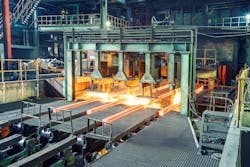Supplier Spotlight: Ajax/CECO/Erie Press Moves Beyond Forging
In today's highly competitive market, businesses need equipment that can keep up with the demands of their operations. This is especially true for those in the manufacturing industry, where the quality of machinery directly impacts production output and efficiency.
When experience and quality are crucial for manufacturers, OEMs like Ajax/CECO/Erie Press (ACE) play a vital role. With 145 years of experience in equipment manufacturing and more than 300 years of combined forging knowledge, the OEM is the longest-running, most experienced forging company in the world.
Today, ACE is the largest OEM forging equipment supplier in North America, providing a comprehensive array of forging equipment including upsetters, presses, programmable hammers, forging rolls, and automation solutions for various forging materials such as carbon steels, aluminum, titanium, and super alloys.
However, due to numerous mergers and acquisitions over the past several decades, ACE manufactures and supports a wide range of equipment well beyond forging.
Now ACE offers high-volume, specialty metal forming machines including compression molding, powder compacting, hot forming, superplastic forming, stretch forming, and contour roll forming.
A Brief History
In 2005, Ajax, a forging equipment OEM since 1875, purchased the intellectual property of the Chambersburg Engineering Company (CECO) to become Ajax-CECO.
In 2020, Park Ohio acquired Erie Press Systems, which has offered custom hydraulic presses for a variety of applications including forging, metal forming, carbon extrusion, composite presses, stretch forming, legacy hammers, and standard mechanical forge presses since 1895.
ACE's acquisition and merger streamlines equipment maintenance and repair for manufacturers with any of its brands in their production plants.
“With the companies combining, we have additional resources to share, so we can respond to support requests faster and have more field service technicians available. Our investment in R&D and new technology has also improved,” says Bill Goodwin, ACE Vice President of Sales and Engineering.
Regardless of the type of equipment, most require the application of extraordinary temperature and pressure. Given the stress of the process, manufacturers that seek to maximize the output of their machinery can benefit from working with an OEM like ACE that has a combined expertise of 145 years manufacturing, maintaining, or upgrading this type of equipment.
According to Goodwin, there are many commonalities in the approach ACE takes to ensure manufacturers can speed production, increase safety, and minimize downtime.
Repair
The high-volume, high-force nature of forging or metal-forming machinery eventually takes its toll. The most immediate, economical option is simply to repair existing or out-of-commission units to get them up and running to spec with greater efficiency. This can be as simple as replacing parts that are worn, out-of-tolerance, or broken to bring the machinery back online.
“To reduce potential production downtime, we stock a lot of the perishable items that are common to every machine,” says Goodwin.
However, manufacturers can get into trouble when a part they need to replace was built decades ago and they do not know if the OEM is still in business—or even if a drawing of the part still exists.
When manufacturers resort to sending parts to machine shops to be reverse-engineered and machined, problems occur. Machine shops often do not have access to critical specifications about high wear parts including the material grade of the steel, the heat-treating process utilized, and tolerances that all were engineered specifically for that piece of equipment.
To prevent such problems, OEMs like Ajax-CECO offer stocking programs for long lead time items such as main gears, eccentric shafts, rams, etc. that most customers do not stock due to the cost. In this type of program, the part is held in inventory for the customer, who pays a percentage of the cost and then the balance when they take possession of the part—even if years later.
In addition, a custom stocking program with minimal up-front investment can eliminate months of downtime due to long lead time parts.
“Multiple machines with parts of similar size and design can have the parts manufactured to a semi-finished state in preparation for use with any of the machines. When needed, the exact dimensions for the down machine can be provided so the part can be completed to spec, ready to install,” says Goodwin.
Automation Upgrades
Automation upgrades for various manufacturing equipment are growing in importance and sophistication every year. Tasks that were once performed manually are now automated to minimize the requirement for skilled labor while improving worker safety.
“Most automation requests are for control consoles and material handling and conveying equipment to transport the material into the equipment,” says Goodwin.
To maximize manufacturer productivity, the OEM often incorporates automated part loading/unloading and improved tool change systems into their machines. Repetitive tasks can now be replaced with robotic arms or servos that can move parts through various processing stages of the manufacturing process with greater speed, accuracy, and safety. More automated forms of conveying and material handling can also be utilized to further boost productivity.
Advanced HMIs
For a wide range of manufacturing equipment, Human-Machine Interfaces (HMIs) are enhancing production uptime and control. HMI are software applications that graphically present information to operators about the state of various processes in a format that looks like the actual machine or display panel. The information can be accessed locally (at the machine) or remotely (within the plant or at an offsite location) via PC, laptop, or smartphone.
Next-level HMIs are not only enabling operators to see how equipment is functioning but also to anticipate how it should be performing. This is accomplished with dynamic animated models and schematics, live trending, and diagrams.
“Cutting edge HMIs are visual learning tools for forging operators to observe the normal machine operation, to expedite troubleshooting when something goes wrong,” says Goodwin.
“Even less experienced personnel can look at a well-designed HMI screen, watch the equipment run, and then learn how it functions. Operators can monitor live press positional and force data as the machine transitions through the production cycle. When something is out of sequence or stops abruptly mid-cycle, they can quickly troubleshoot because the HMI provides a graphical window into the machine control system and its processes, identifying problem areas,” adds Goodwin.
ACE simplifies operation by incorporating touchscreen, menu-based HMIs to automate many equipment processes. System monitoring software also enables operators to see how equipment is functioning and speeds up local/remote diagnostics and troubleshooting. The HMI also improves real-time remote support such as troubleshooting and training direct from the OEM.
Training
Today, manufacturers often lack skilled workers due to retirement so must effectively train younger workers to fill the knowledge gap.
As a solution, state-of-the-art augmented reality (AR) technology is soon to be used to provide expert step-by-step forging machinery support and training remotely in minutes. The new virtual tools allow equipment OEMs to troubleshoot and deliver problem-solving guidance to factory operations and service teams without meeting physically on-site.
The approach involves real-time video communications, so both parties view the physical equipment simultaneously. AR tools also allow either party to make digital annotations on images and live video, view schematics, and share documents over smartphones, tablets, PCs, or AR headsets.
Using AR technology, equipment OEMs like ACE can accelerate problem resolution by as much as 90% and cut training time in half.
Rebuilt and Remanufactured Equipment
When the scope of work goes beyond repair, a machine rebuild is an economical, accelerated option to bring additional equipment online.
“It takes much less time to rebuild equipment than to make and ship a new machine. Depending on the scope of the work, it can take just a few months for a rebuilt unit to become operational,” says Goodwin.
In a rebuild, all high-wear items such as bearings, bushings, seals, and liners are replaced to get the machine in good working condition. All major components, including the frame, are inspected and repaired, if necessary. Recommendations are provided to the customer and the final work scope is developed to meet their needs. This approach significantly reduces the overall cost of the equipment compared to purchasing new.
Rebuilds can be approached in several different ways. The forging equipment can be sent to the OEM for rebuilding; the OEM can send repair personnel to the manufacturer’s facility to rebuild equipment on-site; or the OEM can supervise a rebuild by maintenance staff. This allows the in-house staff to ask questions and better understand the operation of the equipment they are maintaining.
The challenge is that critical engineering design data is often lost when an independent rebuilder reverse-engineers a part. Without the benefit of the original design specifications, there is the risk of a wrong or sub-optimal part being used in the rebuild. Given the loads placed on specialized production machinery, even minor material changes can significantly affect equipment longevity.
Expediting quality repairs and rebuilds requires historical data and support, and no one knows the equipment like the OEM. The OEM has the original design specifications. It is essential information as it pertains to the design principles, engineering data, critical component specifications and is fundamental to an understanding of what the equipment was originally designed and built to do.
In such cases, ACE’s extensive equipment expertise of even legacy machinery enables superior support. With an archive of historical data and details, the OEM can provide original specifications for machines over 50 years old, enabling the supply of quality parts specifically designed for the manufacturer’s machine.
“If a manufacturer needs a part for hundred-year-old equipment, ACE often has the prints for it, so we can supply replacement parts or provide a good substitute. That is just not possible from the overseas options that were not even in business 10 years ago,” says Goodwin.
If even more extensive work is required, remanufacturing the equipment can still save time over buying new. Remanufacturing forging equipment, for example, basically means stripping down the machine to the cast frame and replacing all the internal parts.
“With a remanufacture you save time over having a new frame cast,” says Goodwin. “A remanufacture can be completed faster than a buying new at about 85% to 90% the cost and would usually carry a new machine warranty.”
In today's competitive market, manufacturers need high-quality machinery to ensure efficient production. With a legacy spanning 145 years and over 300 years of combined forging expertise,
Ajax/CECO/Erie Press (ACE) has evolved through numerous mergers.
These acquisitions have enabled ACE to streamline equipment maintenance and repair, enhance support services, and invest in R&D and new technologies to help manufacturers maximize production, increase safety, and minimize downtime.
Please visit the Ajax/CECO/Erie Press website at www.AjaxErie.com or email them at [email protected]. Or, if you prefer, call (814) 455-3941.
About the Author

Del Williams
Del Williams is a technical writer based in Torrance, California. He writes about health, business, technology, and educational issues and has an M.A. in English from C.S.U. Dominguez Hills.
